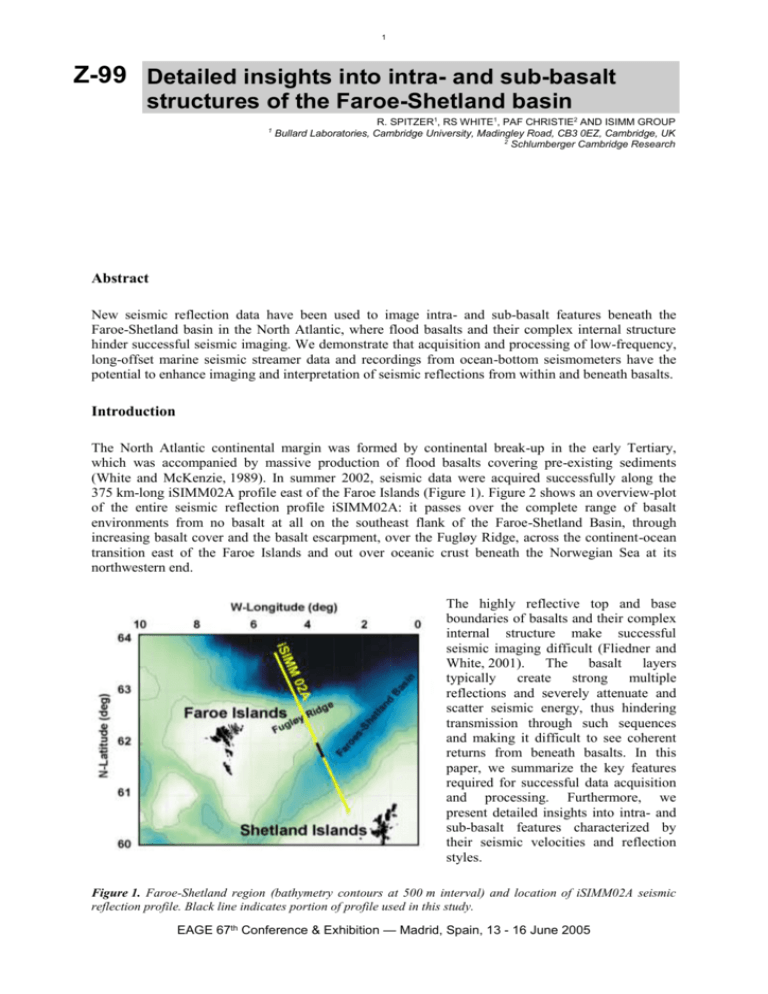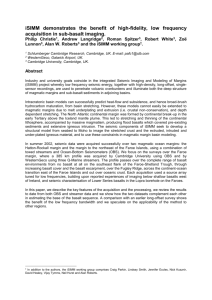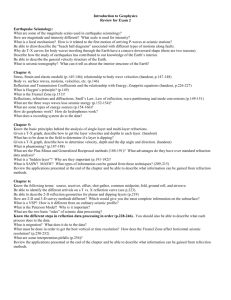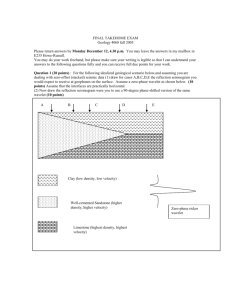EAGE Madrid 2005 RS abstract
advertisement

1 Z-99 Detailed insights into intra- and sub-basalt structures of the Faroe-Shetland basin 1 R. SPITZER1, RS WHITE1, PAF CHRISTIE2 AND ISIMM GROUP Bullard Laboratories, Cambridge University, Madingley Road, CB3 0EZ, Cambridge, UK 2 Schlumberger Cambridge Research Abstract New seismic reflection data have been used to image intra- and sub-basalt features beneath the Faroe-Shetland basin in the North Atlantic, where flood basalts and their complex internal structure hinder successful seismic imaging. We demonstrate that acquisition and processing of low-frequency, long-offset marine seismic streamer data and recordings from ocean-bottom seismometers have the potential to enhance imaging and interpretation of seismic reflections from within and beneath basalts. Introduction The North Atlantic continental margin was formed by continental break-up in the early Tertiary, which was accompanied by massive production of flood basalts covering pre-existing sediments (White and McKenzie, 1989). In summer 2002, seismic data were acquired successfully along the 375 km-long iSIMM02A profile east of the Faroe Islands (Figure 1). Figure 2 shows an overview-plot of the entire seismic reflection profile iSIMM02A: it passes over the complete range of basalt environments from no basalt at all on the southeast flank of the Faroe-Shetland Basin, through increasing basalt cover and the basalt escarpment, over the Fugløy Ridge, across the continent-ocean transition east of the Faroe Islands and out over oceanic crust beneath the Norwegian Sea at its northwestern end. The highly reflective top and base boundaries of basalts and their complex internal structure make successful seismic imaging difficult (Fliedner and White, 2001). The basalt layers typically create strong multiple reflections and severely attenuate and scatter seismic energy, thus hindering transmission through such sequences and making it difficult to see coherent returns from beneath basalts. In this paper, we summarize the key features required for successful data acquisition and processing. Furthermore, we present detailed insights into intra- and sub-basalt features characterized by their seismic velocities and reflection styles. Figure 1. Faroe-Shetland region (bathymetry contours at 500 m interval) and location of iSIMM02A seismic reflection profile. Black line indicates portion of profile used in this study. EAGE 67th Conference & Exhibition — Madrid, Spain, 13 - 16 June 2005 2 Figure 2. iSIMM02A seismic reflection profile. Box marks the location of seismic reflection data shown in detail in Figure 3. Black triangles indicate 85 OBS positions, blue triangle denotes location of OBS 29 shown in this study. TB indicates the top-basalt boundary, BB the interpreted base-basalt reflection, and BM the interpreted Cretaceous basement reflection. Data courtesy of WesternGeco. Data acquisition and processing Stacked basalt flows typically exhibit a low-pass character to seismic waves (Ziolkowski et al., 2003). Therefore, an airgun array was designed to produce constructive interference of the first bubble pulses of the individual airguns (Avedik et al., 1996), which yields a significant amount of low-frequency energy in the resulting seismic signal. Additionally, the large tow depth of the air-gun array of 18 m further enhances the low-frequency, broad-band character of the seismic source signature. Details of the source design and data acquisition are published by White et al. (2002) and Christie et al. (2005). Other typical characteristics of stacked basalt flows are the high impedance contrasts between the intra-basalt layers and the large velocity contrast at the top-basalt boundary, which both cause significant loss of seismic energy. To compensate for the seismic loss, and to produce a low-frequency source we used a large air-gun array with a total volume of 167 litres (10,170 cu. in). To maximise aperture for the reflected sub-basalt wavefield, long-offset data were acquired along the iSIMM02A profile by M/V Geco Topaz with a 12 km streamer. WesternGeco’s Q-Marine acquisition system allows such large source-receiver offsets to be recorded with a small (3.125 m) receiver sampling interval, which greatly benefits subsequent data processing. Four-component OBS were also deployed along the profile (Figure 2), primarily to image the deeper crust and the uppermost mantle. However, information from these recordings was also used to confirm velocity estimates from the streamer data by examining diving waves through the basalt layer (Figure 3). The OBS line was shot by the RRS Discovery, with airgun tuning modes similar to those used for the streamer acquisition (Lunnon et al., 2003). The source array for the OBS acquisition was designed for maximum output in the 5−20 Hz band, based on expected losses from effective Q estimates derived from the Lopra borehole seismic analysis (Christie et al., 2005). The processing sequence for the iSIMM02A profile comprises shot-by-shot designature, extensive de-multiple processing followed by pre-stack Kirchhoff time migration. To reduce multiple reflections a 3-step process was followed: two passes in the Radon domain to suppress multiples from the sea floor and the top-basalt boundary, and wavefield inversion based on the Kirchhoff integral to suppress intra-basalt peg-leg multiples. The last step required uniform and dense shot and receiver distribution, for which the Q-Marine system was ideal. Subsequent migration velocity analyses yield detailed interval velocities, which were used in the interpretation process to characterise the various lithologies. 3 Figure 3. Right panel shows data recorded at OBS 29 (see Figure 2 for location). Left panel illustrates synthetic data modelled at this location (postbasalt events excluded). BB marks base-basalt reflection, BM shows basement reflection (green line on right panel), and TB denotes basalt diving wave (red line on right panel). Fliedner and White (2001) showed that the diving wave eventually hits the base of the basaltic layer and encounters a velocity decrease with depth if it is underlain by sediments. At this point the turning ray terminates and the offset at which this termination occurs depends upon the thickness and vertical velocity gradient of the basalt. Velocities and thicknesses obtained from OBS were used as independent estimates in conventional velocity analyses presented in this study. Interpretation Figure 4a shows the time-to-depth converted interval velocity field and Figure 4b the pre-stack time migrated data along iSIMM02A, both with the geological interpretation superimposed. The velocities within the post-basalt sediments increase from ~1.6 km/s at the sea floor to ~2.8 km/s at the top-basalt boundary and the seismic facies of these sediments (light yellow) is characterized by moderate amplitude, strong continuous seismic reflections. Below this a steep velocity gradient occurs in the first ~200 m of the basaltic sequence, followed by a continuous increase from ~4.5 km/s to ~5.8 km/s within the ~2.5 km thick basalts. The orange coloured regions denote this massive basaltic sequence. Figure 4. (a) Interval velocity field and (b) pre-stack time migrated section with interpretation superimposed, both after time-to-depth conversion. Velocities are consistent with those seen in the Lopra borehole (Christie et al., 2005). The layer beneath the basalt flows (yellow) is also part of the volcanic phase, but clearly different from the flood basalts. The reflection character changes from high amplitudes and strong continuous events in the massive basalts to relatively low amplitudes and only moderately continuous horizons, which indicates the transition into more heterogeneous hyaloclastite basalt breccias interbedded with tuffs, sediments, and probably also sills. Furthermore, at a depth of ~5 km a velocity inversion from ~5.8 km/s to ~5.2 km/s occurs in both data sets, indicating the boundary between massive basalt flows and underlying hyaloclastites. Another velocity inversion from ~5.2 km/s to ~4.5 km/s can be EAGE 67th Conference & Exhibition — Madrid, Spain, 13 - 16 June 2005 4 observed at a depth of ~7 km, which might be caused by the sub-basalt sediments (green) overlying presumed Cretaceous basement (brown). Conclusions We conclude that recording low-frequency, long-offset data significantly improves the confidence in data processing and subsequent interpretation of intra-basalt and sub-basalt features. The seismic reflection data set recorded along iSIMM02A reveals small-scale structures in this highly complex environment and, in combination with the long-offset OBS recordings, provides accurate information on the seismic velocities within and below the basalts, which are important both for improving the quality of the seismic imaging and in interpreting the lithologies. Acknowledgements The iSIMM data were collected by WesternGeco using their Q-Marine system. WesternGeco also provided the Omega software to process the iSIMM data. We thank our colleagues in the iSIMM (integrated Seismic Imaging and Modelling of Margins) study group which, with the authors, comprises N. J. Kusznir, A. M. Roberts, J. Eccles, N. Hurst, Z. C. Lunnon, C. J. Parkin, A. W. Roberts, L. K. Smith and V. Tymms. iSIMM is supported by the UK’s NERC, the DTI, Amerada Hess Ltd., Anadarko, BP, ConocoPhillips, ENI UK, Shell, Statoil and WesternGeco. The OBS were provided by GeoPro GmbH. Dept. Earth Sciences, Cambridge contribution ES.8070. References Avedik, F., Hirn, A., Renard, V., Nicolich, R., Oliver, J. L., and Sachpazi, M. 1996. Single bubble marine source offers new perspectives for lithospheric exploration: Tectonophysics, 267, 57–71. Christie, P. A. F., Langridge, A., Spitzer, R., White, R. S., Lunnon, Z., Roberts, A. W., and the iSIMM working group. 2005. iSIMM demonstrates the benefit of high-fidelity, low-frequency acquisition in sub-basalt imaging: Expanded Abstracts 559, presented at Petrotech, New Delhi, India, 16-19 January, 2005. Fliedner, M. M., and White, R. S. 2001. Seismic structure of basalt flows from surface seismic data, borehole measurements, and synthetic seismogram modeling: Geophysics, 66, 1925–1936. Lunnon, Z. C., Christie, P. A. F., and White, R. S. 2003. An evaluation of peak and bubble tuning in sub-basalt seismology: modelling and results: First Break, 21, 51–56. White, R., and McKenzie, D. 1989. Magmatism at rift zones: The generation of volcanic continental margins and flood basalts: Journal of Geophysical Research, 94, 7685–7729. White, R. S., Christie, P. A. F., Kusznir, N. J., Roberts, A., Davies, A., Hurst, N., Lunnon, Z., Parkin, C. J., Roberts, A. W., Smith, L. K., Spitzer, R., Surendra, A., and Tymms, V. 2002. iSIMM pushes frontiers of marine seismic acquisition: First Break, 20, 782786. Ziolkowski, A., Hanssen, P., Gatliff, R., Jakubowicz, H., Dobson, A., Hampson, G., Li, X., and Liu, E. 2003. Use of low frequencies for sub-basalt imaging: Geophysical Prospecting, 51, 169−182.






